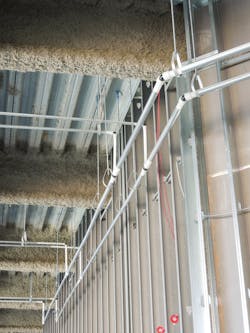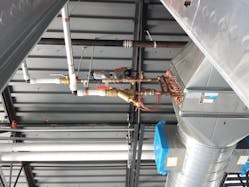In a hydronic system, pipe transfers water from a heating or cooling source, such as a boiler or chiller, to terminal units, such as baseboard radiators, fan coils, or variable-air-volume units. Often, engineers and contractors are so intent on sizing the boiler or pump correctly they neglect to think about the system holistically and, thus, fail to design for maximum cost-effectiveness and operational efficiency.
This article discusses the proper sizing and optimization of crosslinked-polyethylene (PEX) pipe for cost-effective, consistent performance over the life of a hydronic system.
Benefits of PEX
Currently, there are three methods of manufacturing PEX pipe:
- Engel, used to produce PEX-a pipe, which has the highest degree of crosslinking (around 80 percent) for the greatest flexibility, durability, and shape memory.
- Silane, used to produce PEX-b pipe, which has around 65 to 70 percent crosslinking.
- Electron beam, used to produce PEX-c pipe, which has around 70 to 75 percent crosslinking.
Regardless of the manufacturing method used, because PEX pipe can bend with changes in direction, fewer fittings are needed. The elastic properties of PEX-a allow for ASTM F1960, Standard Specification for Cold Expansion Fittings With PEX Reinforcing Rings for Use With Cross-linked Polyethylene (PEX) Tubing, cold-expansion connections, which get stronger as the pipe naturally compresses over them.
The other major benefit of PEX pipe is its long-term performance. Copper and other metallic piping materials perform dynamically, meaning their properties change over the course of their lifetimes. For example, in a copper or iron piping system, the buildup of scale affects flow performance. When that happens, the original pipe design plan is impacted because the system’s properties have changed. Engineers and contractors may size systems with this in mind, but such a strategy can translate into higher costs.
Conversely, PEX pipe is static, meaning its properties remain constant over the course of its lifetime. It will never pit, scale, or corrode, eliminating the need to oversize. This also means that once PEX is designed and sized, it will continue to function in the same manner moving forward.
Sizing Basics
In sizing any hydronic system, engineers and contractors first calculate the flow rate needed to meet the heating or cooling demand. Flow rate is a function of the mechanical properties of a fluid, the heat loss of the space to be served, and the fluid’s temperature differential. Insufficient flow causes uneven heating or cooling throughout a building, while too much flow causes equipment to short-cycle, work inefficiently, and fail more quickly. A simple formula for calculating flow rate for 100-percent water systems is:
gpm = Btuh ÷ (∆T × 500)
For illustration, consider a fan-coil unit requiring 20,000 Btu of energy per hour. The temperature differential is 20°F. Inserting those values into the formula yields a required flow rate of 2 gpm. One can arrive at a total flow rate for a system by adding individual terminal-unit flow rates.
A flow rate must remain within certain boundaries—namely, minimum design velocity, maximum design velocity, and maximum allowable head pressure per 100 ft of pipe. The following values are typical for engineers’ and contractors’ designs:
- Minimum design velocity of 1.5 fps.
- Maximum design velocity of 5 fps.
- Pressure loss of no more than 4 ft per 100 ft of pipe.
Engineers and contractors cross-reference this information with available pipe-sizing charts to identify a pipe that will deliver the required flow within boundary conditions for an entire building. Many pipe-sizing charts commonly used in the industry employ either the Hazen-Williams equation or the Darcy–Weisbach equation.
Most engineers and contractors initially size for copper or some other metallic piping. Next, they use the calculated flow rates to convert from metallic to PEX piping while upholding all hydraulic characteristics.
Understanding the hydraulics in a system is critical when sizing. Consider a garden hose with evenly spaced holes in it. Because water takes the path of least resistance, flow will be greatest in the hole nearest the water source and least in the hole farthest from the water source. The same principle holds true for any piping system, which is why it is important to identify the most demanding unit. The path from the heat or cooling source to the most demanding unit is called the path of most resistance (most head loss) and will determine the pump’s requirements for differential pressure.
Balancing valves typically are used to regulate flow throughout a piping system. Much like one putting his or her thumb over a hole in a garden hose, balancing valves ensure proper flow to each unit in a system. It is important to remember that in the conversion of a design from metallic piping to PEX, the hydraulic characteristics must remain constant for proper operation to be ensured.
Optimization
An additional step that can be taken in the sizing of a PEX hydronic system involves optimization of the pipe design. Converting from copper to PEX will uphold the hydraulics in a system, but likely not maximize operational efficiency. For that, some fine-tuning is required.
Some manufacturers design their PEX pipe so it performs much of the hydraulic balancing in a system, a job traditionally of balancing valves. In general, the lesser the demand placed on balancing valves, the greater the ability of a control valve to have authority over the coil to each unit. This ensures high modularity of flow with respect to valve position and coil output while raising a building’s operational efficiency. This is because the control valve undergoes less short-cycling, which allows flow to be modulated according to load.
Conclusion
Optimizing a PEX pipe system can yield a number of cost-saving benefits, including smaller average pipe diameter, which translates to smaller valves, transition fittings, and hangers, less insulation, and lower labor costs.
Hydraulically balancing a system with piping, though time-consuming and complex, can add tremendous value in terms of upfront costs and ensure efficient and static performance down the road.
For the engineer or contractor, it is critical to devote the time and effort necessary to properly size a hydronic piping system. It can mean the difference between an inefficient, inconsistently performing pipe network and a smooth-functioning, low-cost system that operates statically for life.
Aaron Stotko is associate product manager, heating and cooling, for Uponor. He can be contacted at [email protected].











